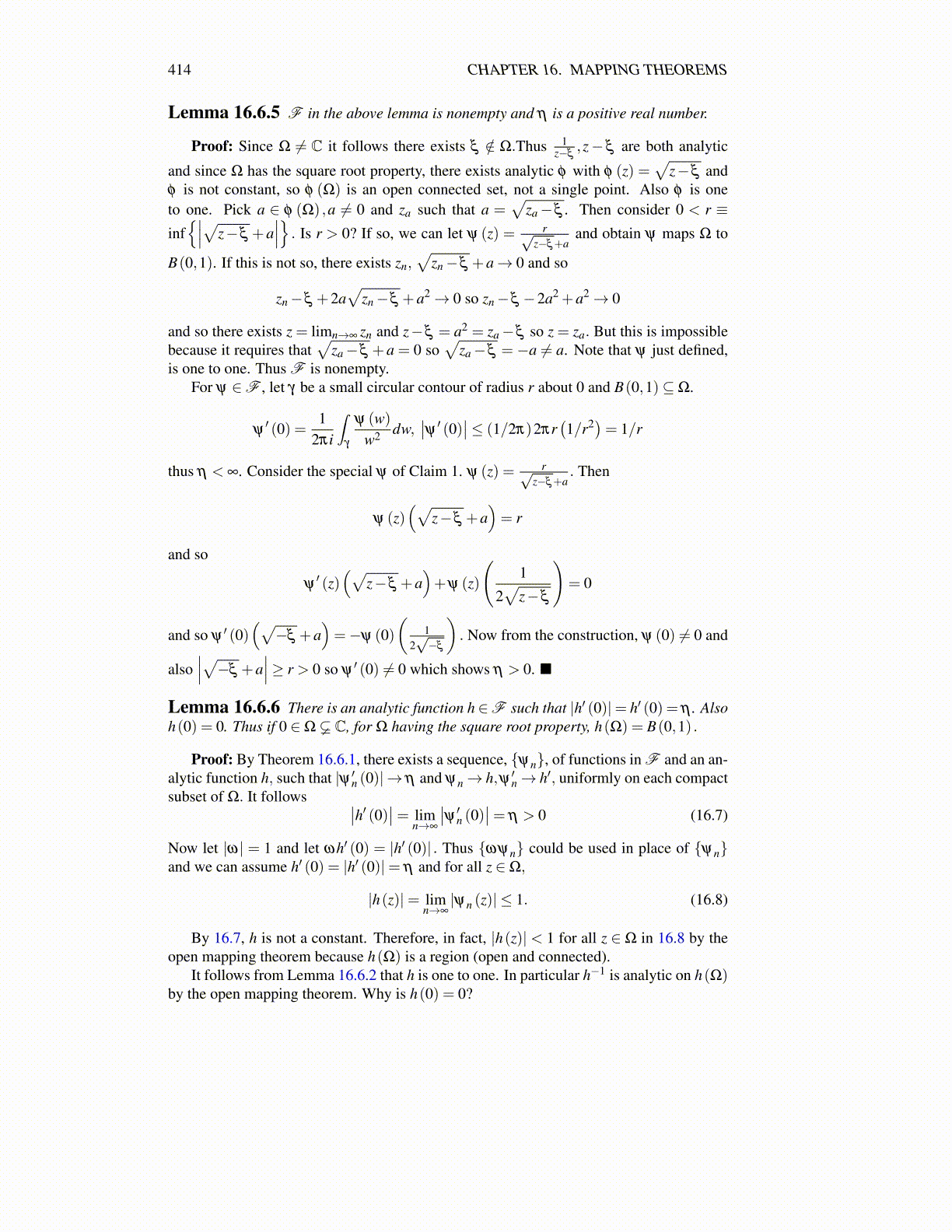
414 CHAPTER 16. MAPPING THEOREMS
Lemma 16.6.5 F in the above lemma is nonempty and η is a positive real number.
Proof: Since Ω ̸= C it follows there exists ξ /∈ Ω.Thus 1z−ξ
,z− ξ are both analytic
and since Ω has the square root property, there exists analytic φ with φ (z) =√
z−ξ andφ is not constant, so φ (Ω) is an open connected set, not a single point. Also φ is oneto one. Pick a ∈ φ (Ω) ,a ̸= 0 and za such that a =
√za−ξ . Then consider 0 < r ≡
inf{∣∣∣√z−ξ +a
∣∣∣} . Is r > 0? If so, we can let ψ (z) = r√z−ξ+a
and obtain ψ maps Ω to
B(0,1). If this is not so, there exists zn,√
zn−ξ +a→ 0 and so
zn−ξ +2a√
zn−ξ +a2→ 0 so zn−ξ −2a2 +a2→ 0
and so there exists z = limn→∞ zn and z−ξ = a2 = za−ξ so z = za. But this is impossiblebecause it requires that
√za−ξ +a = 0 so
√za−ξ = −a ̸= a. Note that ψ just defined,
is one to one. Thus F is nonempty.For ψ ∈F , let γ be a small circular contour of radius r about 0 and B(0,1)⊆Ω.
ψ′ (0) =
12πi
∫γ
ψ (w)w2 dw,
∣∣ψ ′ (0)∣∣≤ (1/2π)2πr(1/r2)= 1/r
thus η < ∞. Consider the special ψ of Claim 1. ψ (z) = r√z−ξ+a
. Then
ψ (z)(√
z−ξ +a)= r
and so
ψ′ (z)
(√z−ξ +a
)+ψ (z)
(1
2√
z−ξ
)= 0
and so ψ ′ (0)(√−ξ +a
)=−ψ (0)
(1
2√−ξ
). Now from the construction, ψ (0) ̸= 0 and
also∣∣∣√−ξ +a
∣∣∣≥ r > 0 so ψ ′ (0) ̸= 0 which shows η > 0. ■
Lemma 16.6.6 There is an analytic function h∈F such that |h′ (0)|= h′ (0) = η . Alsoh(0) = 0. Thus if 0 ∈Ω⊊C, for Ω having the square root property, h(Ω) = B(0,1) .
Proof: By Theorem 16.6.1, there exists a sequence, {ψn}, of functions in F and an an-alytic function h, such that |ψ ′n (0)| → η and ψn→ h,ψ ′n→ h′, uniformly on each compactsubset of Ω. It follows ∣∣h′ (0)∣∣= lim
n→∞
∣∣ψ ′n (0)∣∣= η > 0 (16.7)
Now let |ω| = 1 and let ωh′ (0) = |h′ (0)| . Thus {ωψn} could be used in place of {ψn}and we can assume h′ (0) = |h′ (0)|= η and for all z ∈Ω,
|h(z)|= limn→∞|ψn (z)| ≤ 1. (16.8)
By 16.7, h is not a constant. Therefore, in fact, |h(z)| < 1 for all z ∈ Ω in 16.8 by theopen mapping theorem because h(Ω) is a region (open and connected).
It follows from Lemma 16.6.2 that h is one to one. In particular h−1 is analytic on h(Ω)by the open mapping theorem. Why is h(0) = 0?